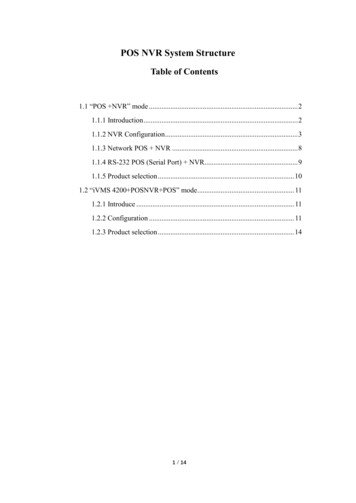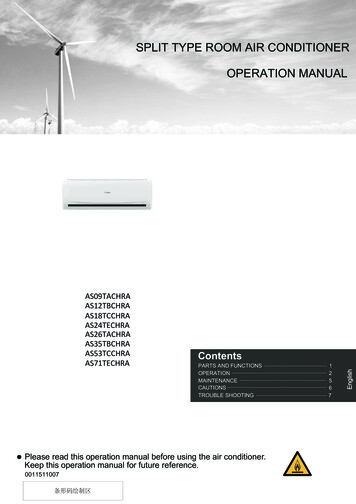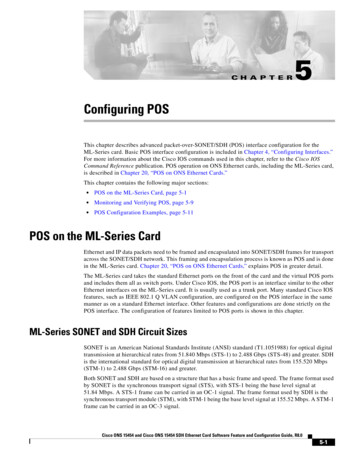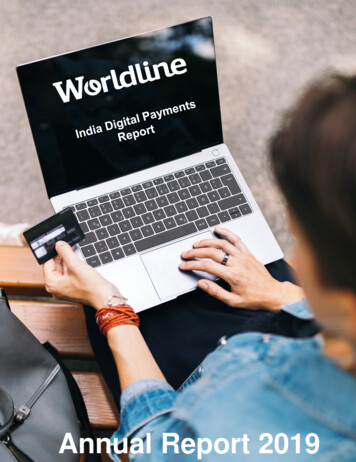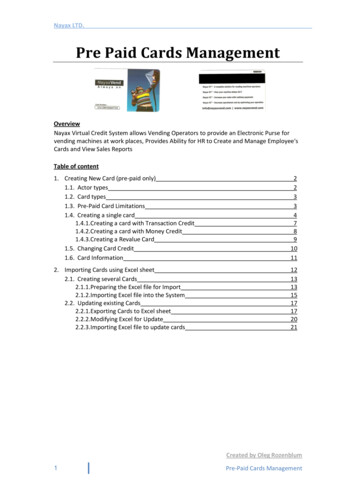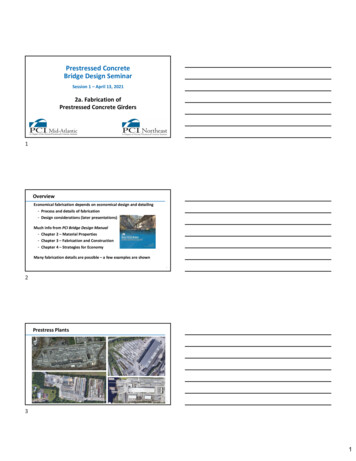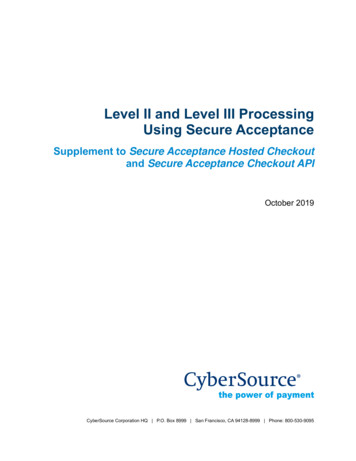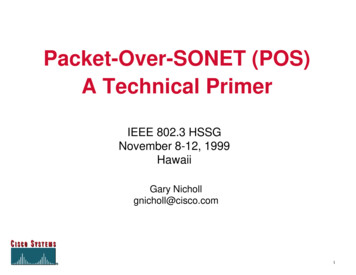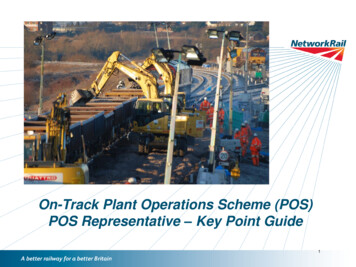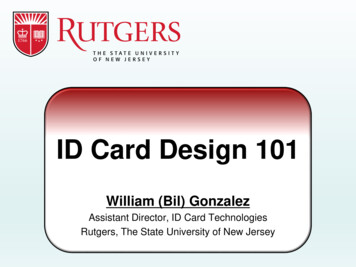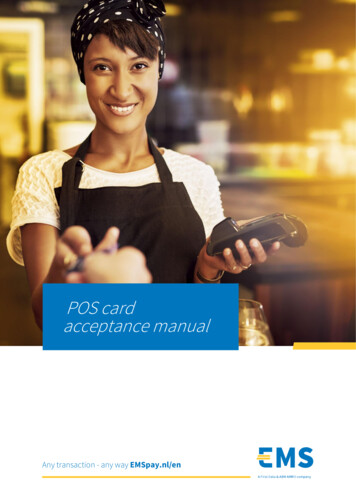
Transcription
POS cardacceptance manualAny transaction - any way EMSpay.nl/en
Contents1. Introduction . 32. How to recognise a valid credit card . 33. Acceptance using the payment terminal . 104. Payment . 115. Retrieval requests & chargebacks . 116. Secure acceptance . 137. Inform us about changes in your business details . 148. Payment Card Industry Data Security Standard . 149. Important addresses and contact information. 16Appendix A - Card organisations’ rules and provisions . 17Appendix B - EMS special terms for payment methods . 192
1. IntroductionEMS provides the processing and payment for the transactions that you accept with Visa, MasterCard, Diners, Discover,UnionPay, JCB, Foreign Maestro card, V PAY, and Bancontact cards. In order to provide you with the best possibleservice, we have set out all the important information for you in this manual. This manual forms part of your contractwith EMS. We would ask you to read the manual carefully and then store it in a central location near your till and/orpayment terminal. That way you will be sure that you have the right information to hand in the event of queries.2. How to recognise a valid credit cardBefore accepting a card, you must check that it is valid. It is easy to check the validity because all cards have standardcharacteristics. It is also important that you only accept cards that have been authorised by us and for which you havesigned an Acceptance Contract with us. In addition, you must always process a transaction using the EMV chip. Only if thepayment terminal then indicates that the magnetic strip should be used can you use the magnetic strip.A card is strictly personal, and only the cardholder themselves may use the card. A card with no signature or more thanone signature on the signature strip is not valid.The summary below lists the most important characteristics for you.Visa cardCharacteristics of the Visa card:1.2.3.4.5.6.The logo can appear in various positions on the card, both horizontally and vertically.If you examine the Visa logo under UV light, the letter ‘V’ will be visible.The Visa dove appears in the middle of the card under UV light.The EMV chip. This chip is read by inserting the card in the payment terminal, after which the payment iscompleted. This is more secure than using the magnetic strip.Visa magnetic strip. The Visa hologram with the dove can be located both on the front or in the magneticstrip or another position on the back of the card.CVV2 code (Card Verification Code): the security code that is located on the signature strip. The security code cannow also be located next to the signature strip instead of on it.Any transaction - any way EMSpay.nl/en3
Visa Electron cardThe Visa Electron card is a Visa card that can only be used for electronic transactions using a payment terminal and/orATM. Every transaction is then checked, authorised, and processed immediately by the Visa systems. There are now over394 million Visa Electron cardholders worldwide. The authenticity of this Visa card can also be checked easily using anumber of standard characteristics.Characteristics of the Visa Electron card:1.2.3.4.5.The logo can appear in various positions, both horizontally and vertically.If you examine the Visa logo under UV light, the letter ‘V’ will be visible.The EMV chip.Visa magnetic strip with hologram.Signature strip and CVV2 code: the security code (CVV2) can also be located next to the signature strip insteadof on it.A sales transaction with the Visa Electron card:This may only be performed using a payment terminal and/or ATM. Visa Electron cards may not be accepted manually,because all the data is incorporated in the card’s EMV chip and is therefore not embossed on the card. 4If there is a problem the cardholder needs to use another payment method.The Visa Electron card’s chip must always be read by the payment terminal. You may not key in the card number(if it is legible).A code is displayed with a rejected transaction. If you have any questions about the reason for the rejection, pleasecontact our Client Services department using our contact form, or take a look at our support pagewww.emspay.nl/en/support
V PAY cardCharacteristics of the V PAY card:1.2.3.4.5.EMV chip.V PAY logo. The logo can also appear in a different position on the front of the card.UV light. If you examine the new V PAY logo under UV light, the letter ‘V’ will be visible.Flat card. The card number is not embossed on the front.Magnetic strip. The hologram with the dove may be optional on the magnetic strip.All V PAY cards contain a chip. When paying with a V PAY card, the cardholder is asked to enter a PIN. This ensures amore secure payment for everyone.MasterCardCharacteristics of the MasterCard:Front1. The MasterCard logo can appear in various positions on the card, both horizontally and vertically.2. The hologram with the globes (silver or gold). Check the hologram for damage, because this can indicate that thecard has been tampered with.3. The card number always begins with the number 5 (five) or 2 (two).4. The card number contains 13 or 16 digits, the last three or four of which areembossed in the hologram. Check that the numbers on the card are the same size, height, and style, and whetherthey are aligned.5. The first four digits of the card number match the preprinted numbers on the card.6. ‘Valid thru’: The date up to which the MasterCard is valid is embossed below this. After this expiry date theMasterCard can no longer be accepted (up to the last day of the month in question).7. EMV chip.Any transaction - any way EMSpay.nl/en5
Back8. The magnetic strip.9. The cardholder’s signature must always appear on the back of the card. The strip on which this signature is placedmust be undamaged and printed diagonally with the text ‘MasterCard’. The signature strips on most current cardshave a new characteristic: the strip changes colour if it is tampered with. The signature on the back of the cardmust match the signature on the sales voucher.10. The security code: these are the last three numbers on the signature strip on the back of the card. This code iscalled the CVC2 code, which stands for Card Verification Code.Foreign Maestro cardThe foreign Maestro card is a card that can only be used for electronic transactions using a payment terminal and/or ATM. Every transaction is then checked, authorised, and processed immediately by the Maestro systems. Theauthenticity of this card can also be checked easily using a number of standard characteristics.Characteristics of the foreign Maestro card:Front1.2.3.4.5.EMV chipCard number or bank account number (both can appear on the card)Cardholder’s nameExpiry dateMaestro Logo. The logo can also appear in a different location on the card.Back6. Cirrus brand name. Does not need to be present.7. Logo of the acceptance mark8. Signature strip9. Magnetic stripA sales transaction with the foreign Maestro card:This may only be performed using a payment terminal and/or ATM. Foreign Maestro cards may not be acceptedmanually, because all the data is incorporated in the card’s chip and is therefore not embossed on the card. If there is aproblem the cardholder needs to use another means of payment. The foreign Maestro card’s chip must always be readby the payment terminal. You may not key in the card number (if it is legible). Make sure that the foreign Maestro cardthat is presented matches the characteristics listed. In the event of doubt please contact our Client Services department.6
UnionPay cardCharacteristics of the UnionPay cardFrontA. Card number, 16 or 19 digits.B. Cardholder’s name (on some UnionPay cards the cardholder’s name is not shown on the card. Howeverthese cards are still valid).C. Expiry date, the embossed date up to which the credit card is valid. After this expiry date the credit card can nolonger be accepted (up to the last day of the month in question).D. UnionPay logo. The card can display an old type of logo (only Chinese lettering) or a new logo (see example).E. The card may also be equipped with a chip on the front. If this is present, the chip must be used. Important credit carddata is stored on this chip.BackF. The cardholder’s signature must always appear on the back of the card. The signature on the back of the creditcard must match the signature that the cardholder signs on the sales voucher. If there is a discrepancy, the cardmay not be accepted.G. 24-hour Customer Service Hotline, the number for UnionPay's 24-hour customer service lineH. 24-hour Customer Service Hotline, the overseas number for UnionPay's 24-hour customer service line.I. Last 4 digits of the credit card number. These 4 numbers must match the last 4 digits on the front of the creditcard.J. CVV2 Code, the security code: these are the last three digits of the number on the signature strip on the back ofthe card.K. UnionPay credit cards always feature a hologram on the front or on the back. This hologram is not present on aUnionPay debit card.L. The magnetic strip.Any transaction - any way EMSpay.nl/en7
Diners CardCharacteristics of the Diners Card:Back The card has a holographic magnetic strip and the symbols on the magnetic strip change if it is tilted. Is there an undamaged signature on the back of the card, and is ‘Diners’ repeated multiple times in thesignature field? Are the full card number or the last four digits of the card number shown in the signature field followed by thethree-digit security number?Front Is the card neatly printed, free of discolouration or other deviations? Cards where the card number and the expiry date are printed on the front of the card should only be usedusing the EMV chip, and no imprint may be taken of them. Do the last four digits of the card match the last four digits recorded on the sales voucher? Does the signature on the sales voucher match the signature on the back of the card?Discover cardCharacteristics of the Discover card:Front Is the card neatly printed, free of discolouration or other deviations? Do the last four digits of the card match the last four digits recorded on the sales voucher? Does the signature on the sales voucher match the signature on the back of the card?Back Does the card have a holographic magnetic strip and do the symbols on the magnetic strip change if it is tilted? Is there an undamaged signature on the back of the card, and is ‘Discover’ repeated multiple times in thesignature field? Is the three-digit security number shown in the signature field?8
JCB cardCharacteristics of the JCB card:1.2.3.4.The card must feature the hologram and the JCB logo on the front;and an embossed JThe signature field on the back features the text ‘JCB’ and an authentication number.The card can feature 2 different JCB logosBancontact cardCharacteristics of the Bancontact card:Front1. The card number is a number made up of 17 digits2. The card’s expiry date in month and year (2 digits for each)3. The cardholder’s name (in capital letters)4. The chip on the card is used by a payment terminal’s card reader or your bank’s card readerBack1. The zone for the cardholder’s signature2. The magnetic stripAny transaction - any way EMSpay.nl/en9
3. Acceptance using the payment terminalAccepting cards using the payment terminal is quick, cheap, easy, secure, and customer-friendly. Virtually allpayments terminals that accept debit cards are also suitable for accepting credit cards and foreign Maestro and VPAY cards. This chapter tells you all about electronic card acceptance. For information about how to operate yourpayment terminal, please see your payment terminal’s user manual. It is important that you have this manual inyour possession and that your employees are informed about error and/or fault messages.Accepting transactions1. Check the characteristics of the card. Only continue if you are satisfied with the checks. After all, your paymentterminal does not carry out all the required checks.2. Place the card in the payment terminal’s chip card reader. If the payment terminal cannot read the card or afault has occurred with the payment terminal, please read the ‘procedure in the event of a fault with thepayment terminal’ later in this chapter.3. Enter the amount and check whether the transaction has been approved.4a If the card has a chip, this must be read in the chip card reader.The customer must then enter their PIN. The sales voucher does not need to be signed and does not need to be kept.If the payment terminal does produce a sales voucher with a request for signature, ask your customer to sign on thesales voucher as verification. Check the signature against the signature on the back of the credit card. You shouldkeep this voucher in case there is a dispute later.4b If the card does not have a chip, the card can be read using the magnetic strip. The customer must enter their PIN. Ifthe terminal does not ask for a PIN, the cardholder must sign the sales voucher.5. Retain the original voucher (for at least 18 months as requestable proof of your transaction) and give the copyto the cardholder.6. Only then should you return the card to the cardholder.Authorising transactionsThe request for an authorisation (approval) for a card payment via an online payment terminal happensautomatically. You therefore do not need to do anything.The authorisation is givenFollow the instructions on the payment terminal, since these differ according to the payment terminal.The authorisation is refusedIn order to safeguard the cardholder’s privacy, EMS will never tell you the reason for refusal over the phone. In that caseyou can ask the customer to use another means of payment.If a cardholder cannot remember their PIN:1.2.3.Remind the cardholder that it may be the same PIN that they used to withdraw cash from an ATM.Remind the cardholder that they can contact the card-issuing bank for help.If the cardholder cannot remember their PIN code the cardholder needs to make payment by other means.Submission of accepted transactionsThe card transactions via a payment terminal are automatically submitted to EMS because the payment terminal has adirect link to our systems. You therefore do not need to send off the signed sales vouchers, but you should keep them forat least 18 months in case of chargebacks. You will also receive payment for the transactions automatically.Cancelling card transactionsYou may need to cancel a transaction in full or in part. In some cases you can cancel the transaction on the spot bycancelling the transaction on the payment terminal. This can only be done on the same day and for the full amount ifyour payment terminal is set up for this. Please consult your payment terminal’s manual for this. In the case of a partialcancellation or cancellation on a day other than the day on which the transaction took place, you must cancel thetransaction using a refund. Please consult your payment terminal’s manual for this.10
If you have entered a cancellation for a transaction on your payment terminal, this will be submitted to us automaticallyvia the systems. You do not need to send us anything else.If the payment terminal cannot read the card, you can follow the following procedure: Always use the EMV chip by inserting the card in the chip card reader. You could also ask the cardholder to pay by other means.After EMS has processed your transactions you will receive payment for them within the agreed number ofworking days.4. PaymentWe will list all information about the transactions—such as quantity, gross amount, commission paid, and date—on thebank statement. You will therefore not receive a hard-copy itemisation from us. You can find detailed information andvarious reports about your transactions in our online reporting tool. For further information please seewww.emspay.nl/enQueries about paymentsWe would ask that you notify queries about payments to EMS in writing or by phone as soon as possible, and definitelywithin three months of the credit card transaction in question. You should always include your merchant number.5. Retrieval requests & chargebacksThis chapter describes the procedure that you must follow for retrieval requests and chargebacks. It also contains tipsthat can help you to avoid chargebacks.Do not forget that you are responsible for chargebacks, even if you have been given authorisation for a transaction. SeeClause 25.2 in our General terms and conditions.A cardholder has the right to ask about a transaction. The cardholder can also indicate that they do not agree with thetransaction. These requests will always be submitted to EMS via the card issuer, and can be submitted (in most cases)up to 180 days after the transaction has been debited from the cardholder’s account. A transaction is only completedwhen all the goods or services have been delivered and the 18 months therefore apply from this date. We thereforerecommend that you always retain the original documents for at least 18 months.Retrieval requestsA cardholder may always request a sales voucher to verify that a transaction actually took place. The cardholder will notifythis to their bank. The bank submits the retrieval request to EMS. EMS will then ask you for a copy of the sales vouchershowing the transaction in question. We will send you this request by e-mail or by post according to your preference.However you bear the risk of the post not arriving. We therefore recommend that you communicate about a retrievalrequest by e-mail.This e-mail/letter will ask you to send us the relevant copy of the sales voucher within 7 days. You are responsible forsending this copy of the sales voucher to us within this period.If for any reason you are unable to provide copies of the requested information, you will risk a chargebackof the transaction in question. If the card issuer makes a chargeback because of the failure to provide the requesteddocuments in time, this cannot be undone by submitting the documentation later. It is therefore extremely importantthat you reply to and/or resolve a retrieval request as soon as possible because of the time limits imposed by Visa,MasterCard, Diners, Discover, JCB, and UnionPay. The more information we have available to us, the better we canprotect your interests. We recommend that you include all documents relating to the transaction (e.g. associatedinvoices/purchase notes) as proof of the transaction, including all documents signed by the cardholder.Any transaction - any way EMSpay.nl/en11
Differences between a retrieval request and a chargebackA retrieval request does not have direct financial consequences. Only if a chargeback is actually submitted on the basis ofthe retrieval request can there be financial consequences for you such as the disputed amount, scheme costs, and EMS’scosts. This depends on whether the bank accepts the information provided by you, the reason for the chargeback, thecosts that the scheme charges, and the costs that you paid to EMS (if a chargeback is lost).ChargebackIf we receive a chargeback from a card issuer we will inform you of this by means of an e-mail notification. If EMS canchallenge the chargeback you will receive a letter giving the reason for the chargeback and what information we needfrom you in order to actually be able challenge the chargeback with the bank. We will also provide the transaction detailsso that you can trace the transaction (more) easily in your records. You then have 7 days to provide the requestedinformation.If the information provided by you is adequate and received within the permitted time limit, we will defend thechargeback for you where possible. This depends on the rules stipulated by Visa, MasterCard, Diners, Discover, JCB, andUnionPay. You will then receive no notification from us.If the information is not adequate, we will contact you to ask you to provide the missing documents.If this is still not adequate, we can unfortunately not defend the chargeback for you, and you will have to pay thechargeback costs. Obviously we will do everything possible to avoid this.Read through the example situations below. These described the most common reasons for chargebacks and howthey can be avoided.12ReasonHow to avoid chargebacksCancellation not processed—the cardholder claims thetransaction should have been cancelled/refunded.Make sure that your refund and/or cancellation isprocessed immediately. Refunds must be made to thesame card number that the cardholder used for theoriginal purchase. Do not make refunds in cash orcheques.Transaction not authorised.Authorise all transactions and use the correct authorisationmethod.The accepting merchant does not respond to requestsfor a copy of the sales voucher.Ensure clearly legible duplicate sales vouchers andstore them in a secure and orderly way so that you areable to respond to retrieval requests within the requiredtime limit.The cardholder does not agree with the transactionbecause the amount has been debited twice.If you notice afterwards that you have received a doublepayment, it is important that you make a refund within 14days. Otherwise the cardholder can initiate a chargeback,and this can involve more costs.
6. Secure acceptanceAccepting credit cards via a payment terminal is quick, secure, and efficient. But there may still be an attempt at fraudat your business. The guidelines below can help you assess whether a transaction is suspicious or not. It is importantthat you and your personnel read, understand, and apply these guidelines about accepting credit cards.How can I identify a potentially fraudulent transaction? The person offering the card does not ask about the price of goods and is buying products that caneasily be sold on; The purchase amount is much higher than your average purchase amount (e.g. you usually sell for an averageamount of 40 per transaction and this is a purchase for 400); The customer takes a long time to place their signature on the sales voucher; The customer has one or more credit cards casually loose in a jacket or trouser pocket instead of in a wallet; The customer tells you that they have already had problems earlier with the credit card being accepted and askyou to try again for a lower amount; The customer asks you to split the amount into portions or to divide the amount across different cards. The customer comes back to you several times in a short period, possibly with different credit cards. Even if the customer has entered a PIN they can still be required to sign the sales voucher. You shouldtherefore always check the sales voucher carefully.The situations described above can indicate a fraudulent transaction. If the offered credit card look suspicious or theperson offering the card shows unusual behaviour (irritated/hurried/nervous), do not hesitate to contact our ClientServices department. For more information about recognising and preventing fraud please visit our websitewww.emspay.nl/en/supportOther important information about fraud An authorisation code merely shows that the cardholder’s credit is available and that the card was not blockedat the time of the transaction. The PIN does not guarantee that the person using the card is the legitimatecardholder. Do not process transactions for businesses other than your own business. Some fraudsters offer money forprocessing transactions.Fraud preventionIn order to protect your business against financial losses it is very important that you and your personnel complycarefully with the contents of this manual at all times. If you are the victim of a fraudulent transaction, we will doeverything possible to help prevent you from suffering financial loss. But often the results are dependent on the degreeto which you have followed and complied with the procedures and guidelines contained in this manual.If you think that your business is vulnerable to attempted fraud, possibly because of the nature or location of yourbusiness or because you have heard it on the grapevine, please contact us and ask for the Risk department. They arehappy to help you with advice on preventing fraud.Any transaction - any way EMSpay.nl/en13
In order to be able to provide you with the best service, it is important to comply with a number of basic rules stipulatedby Visa, MasterCard, Diners, Discover, UnionPay, JCB, and Bancontact. If you have entered into a Cards Acceptance Contract, you are required to display the logos of Visa, MasterCard,Diners, Discover, UnionPay, JCB, and Bancontact in a clearly visible place so that your customers know whichcards you accept. You are not permitted to use the logos of Visa, MasterCard, Diners, Discover, UnionPay, JCB, and Bancontact cardin such a way that it gives the impression that these companies recommend your goods and services. You may not charge a fee for card payments. At least one copy of the sales voucher must be given to the cardholder. You may not stipulate any special conditions for accepting a card, such as minimum ormaximum spends. You cannot carry out a transaction or sale for which a chargeback has been made in the past. You are not authorised to accept transactions for third parties and/or to give cashbacks unless you haveobtained express written permission for this from EMS.7. Inform us about changes in your business detailsIt is important that you keep EMS informed about all changes within your business. It is particularly important that youinform us of the following changes:1.2.3.4.5.6.Change of address.Closure of the business or change of owner; you cannot pass your Acceptance Contract on to someone else underany circumstances without EMS’s written permission. If you do not inform us that you no longer own a business,you will still remain liable for any debts incurred by the new owner.Changes in your business relating to the legal form and/or signing powers.Change of Chamber of Commerce number.Change of products or services offered; when you join EMS you must provide us with details of the variousproducts that your business offers so that we can categorise your business accordingly. It is therefore importantthat you inform us in writing if the nature of your business changes, for example if a product or service changes or ifyou expand your activities with activities in another sector.Change in the method of accepting credit cards. If you wish to change your acceptance method either to‘Cardholder Not Present’ or to ‘Acceptance via the Internet’, you must request a separate Acceptance Contract forthis from us.You must notify all these changes to us in writing, and always quote your merchant number. Our websitehttp://www.emspay.nl/en provides standard forms that we have developed for the most common changes.8. Payment Card Industry Data Security StandardThe Payment Card Industry Data Security Standard (PCI DSS) is a globally required security standard that isprovided by the credit card companies to protect and secure card payment data. Any entity that collects or storescard payment data is responsible for the protection and storage of that data. Failure to comply with this standardcan have serious consequences, including possible fines and penalties from the card organisations. In some casesthey may even withdraw your right to accept credit cards. You are obliged to inform EMS immediately of theidentity of any third party that you use or wish to use to process and/or store card payment and account data,either directly or indirectly, regardless of the method or duration of such activities. Such parties are called DataStorage Entities (DSE) and must also comply with PCI rules.PCI DSS offers a coordinated approach to the protection of sensitive data for all card types and meets the need forstreamlined requirements for the entire payment industry. EMS offers its merchants a PCI DSS programme at a heavilydiscounted rate. The PCI DSS Protection Programme enables merchants to easily comply with the PCI DSS standard.For more information about the EMS PCI DSS Protection Programme, please visit our website www.emspay.nl/en14
Card organisations must ensure that all outlets and businesses that store, process or send card data comply fully with thePCI standard and that this is regularly tested.MasterCard PCI RulesMasterCard can impose f
completed. This is more secure than using the magnetic strip. 5. Visa magnetic strip. The Visa hologram with the dove can be located both on the front or in the magnetic strip or another position on the back of the card. 6. CVV2 code (Card Verification Code): the security code that is located on the signature strip. The security code can
